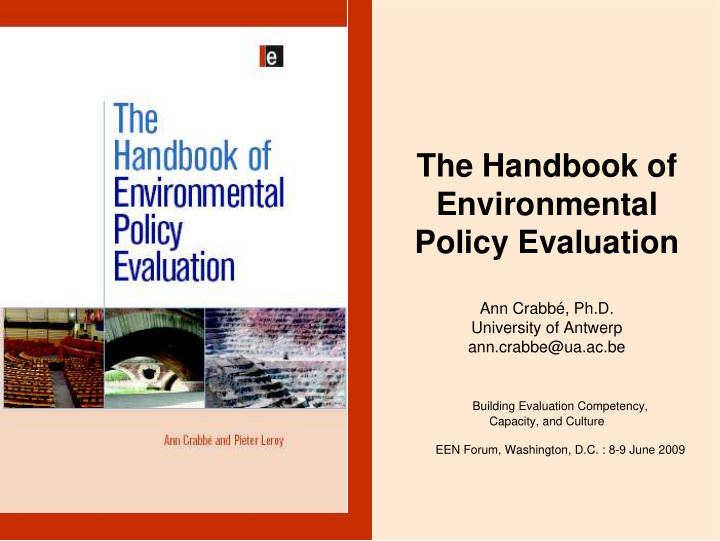



The Handbook of Environmental Policy Evaluation Ann Crabbé, Ph.D. University of Antwerp ann.crabbe@ua.ac.be Building Evaluation Competency, Capacity, and Culture EEN Forum, Washington, D.C. : 8-9 June 2009
The book’s coming into being • Demand for a “cookbook”: linking evaluation questions with evaluation methods • Background: state of the environment reporting focuses on distances to targets, but not on answering why and how questions
• Result: a Dutch version, outlined and edited in co- operation with the target group (civil servants, NGO-representatives) • Built on a post-academic course • Resulting in turn into – presentations – workshops • Two years later: new edition, in English
The book’s content and structure • Perspectives on policy and policy evaluation – goal rationality, political interaction, institutional • Distinct features of environmental policy – typical difficulties of EPE • Series of methods – academically characterised, – and a series of examples, – from all over
Perspectives on policy & policy evaluation – perspective of goal rationality • evaluation of policy theory • impact assessments • (quasi)experiments… – political interactive perspective • responsive evaluation • deliberative democratic evaluation… – institutional perspective • focus on networks, regimes, policy arrangements, discursive coalitions etc.
Criteria for policy evaluation – control and accountability > juridical criteria – effectiveness and efficiency > economical criteria – responsiveness and transparency > political criteria
Typical features of environmental policies – complexity • intervening (f)actors, delineating the object – data availability and data appropriateness • overload and scarcity, (in)appropriateness – time, space and level of analysis • time-lag, relevant selection of space & level of analysis vs level of observation – case studies • single vs plural • quantitative vs qualitative – the position of the evaluator and the evaluation’s impact • in fear of the mirror • utilization
• Series of methods: – not exhaustive, rather: apparently useful – all described with the same framework – with examples of EE from all over the world
Framework method description Elucidation and context • the essence of the method: – what? – when? – advantages and disadvantages? • historical context • position in research and evaluation context Methodology • steps in the application of the method • remarks References • primary and additional references • examples
Chapter 3 1. Needs analysis 2. Programme theory evaluation 3. Case study evaluation 4. Experiment and quasi-experiment 5. Formative/developmental evaluation 6. Goal-free evaluation 7. Impact assessment: • Social impact assessment • Environmental impact assessment • Regulatory impact assessment 8. Cost-benefit analysis and cost-effectiveness analysis 9. Logframe method 10. Multi-criteria analysis 11. Realistic evaluation
Chapter 4 1. Advocate–adversary evaluation 2. Context, input, process and product evaluation (CIPP) model 3. Connoisseurship and criticism 4. Constructivist evaluation 5. Deliberative democratic evaluation 6. Empowerment evaluation 7. Evaluability assessment 8. Meta-evaluation 9. Mixed-method evaluation 10. Responsive evaluation 11. Utilization-focused evaluation
More information: www.earthscan.co.uk
Recommend
More recommend